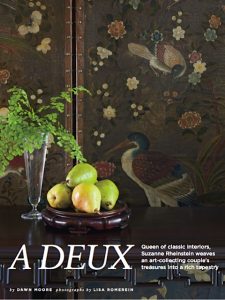“I LOVE THE DETAILS; they’re really important to me.” Anyone who is familiar with the work of Suzanne Rheinstein knows this is an understatement. The New Orleans native is possessed of the most deft hands for luxe textiles and embellishments in the business. This—and her organic ability to meld regional styles—is the very reason a philanthropic Montecito couple turned to her to help cull through their freshly combined lives.
Wanting a space that would accommodate large fund- raising events but was also friendly for quiet evenings at home, the owners of this Mediterranean-style manse presented an additional hurdle: both had extensive collections—his art and her antiques. “Just imagine being handed a very large and comprehensive binder filled with image after image of incredible pieces,” Rheinstein says of her initial meeting with the clients. Intertwining the full and established lives of two serious collectors was a challenge, but “Suzanne was able to make sense of it all,” says the wife.
The expansive ocean-view property had been in the husband’s portfolio and it bubbled with unrealized potential. Armed with a cachet of images from their travels to villas around Italy’s Lake Garda, the couple engaged architect Don Nulty and builders Giffin & Crane and started scheming.
Enter Rheinstein. A fan of both Casa del Herrero and Lotusland, the designer made a point of exploring local collections from William Laman (“his sensibility is superb,” she says), Country House Antiques, Davis & Taft, and Botanik for “stylishly planted containers.” Not much else was needed, given the breadth of the owners’ spectacular collections. Throughout the house, the warm cream Venetian plaster walls act as a canvas for masterworks by fine Santa Barbara artists Lockwood de Forest, Colin Campbell Cooper, and Ray Strong. All the rooms are designed to age with grace, and Rheinstein’s choice of materials echoes that of the patinaed antiques. Even the floors appear to have been in place for decades—the terra- cotta tiles, the reclaimed wood, the limestone entrance—all hand selected with the owners in tow.
Stenciling—a classic Old World device—is used with luscious effect throughout the house. In the powder room, a pattern interpreted from a vintage ikat textile was hand painted from floor to ceiling, the coffered ceiling of the dining room glows with Chinese gold-leaf tea paper, and the main hall’s cross beams are accented with painted designs winking at the Spanish vernacular.
Inspired by the husband and wife’s collection of Delft pottery, the welcoming kitchen’s blues are as soft as the hazy coastal sky. “I envisioned them sitting in front of the fire on a winter morning reading the paper and having their coffee,” Rheinstein says of her starting point for the space. The Italian wingback chairs (from Rheinstein’s celebrated store Hollyhock) covered in a gutsy 18-ounce linen from Rogers & Goffigon are a favorite, while the hand-planed Dennis and Leen farmhouse table anchors the daily gathering place.
Mindful of the edict for user friendliness when just two inhabit the home, Rheinstein also custom designed tasseled banquettes in both the library and living areas to quietly accommodate when two swells to 200. “The husband was very clear. He wanted two separate sofas facing each other for small dinner parties,” says Rheinstein. The designer complied and added a luxurious deep fringe to boot.
As is tradition in southern California, home entertaining usually includes theatrics of some sort. So in a total departure from the rest of the house, a vibrant red wool felt-lined cinema on the lower level provides the required drama with a nod to Hollywood’s 1920s. “We found these fantastic art deco sconces and applied woven cotton tape in a toning shade to the walls to give the illusion of paneling,” says Rheinstein.
But if the weather—and crowd—permit, the terraced gardens designed by Sydney Baumgartner create a natural amphitheater where Italian statues representing the four seasons stand ready to perform at a moment’s notice. The wife notes, “The statues once graced a Scottish estate and a New Orleans mansion, and now they are very much loved right here!”
Recently completing another Santa Barbara project in the modern genre, Rheinstein displayed her agility with Asian and continental antiques arranged in a spare style versus the neoclassicism she’s noted for. But that flexibility is all in a day’s course for the designer, whose book At Home: A Style for Today with Things from the Past is in its fifth printing. “I’m very happy and am beginning the outline of the next one,” she says.
Whether entertaining à deux or en masse, this gracious mash- up of Mediterranean rustic architecture, neoclassical antiques, and silk brocades somehow comes out elegant yet informal, wise yet familiar—just like the inhabitants themselves. And Rheinstein sees that as the biggest compliment of all. ■
